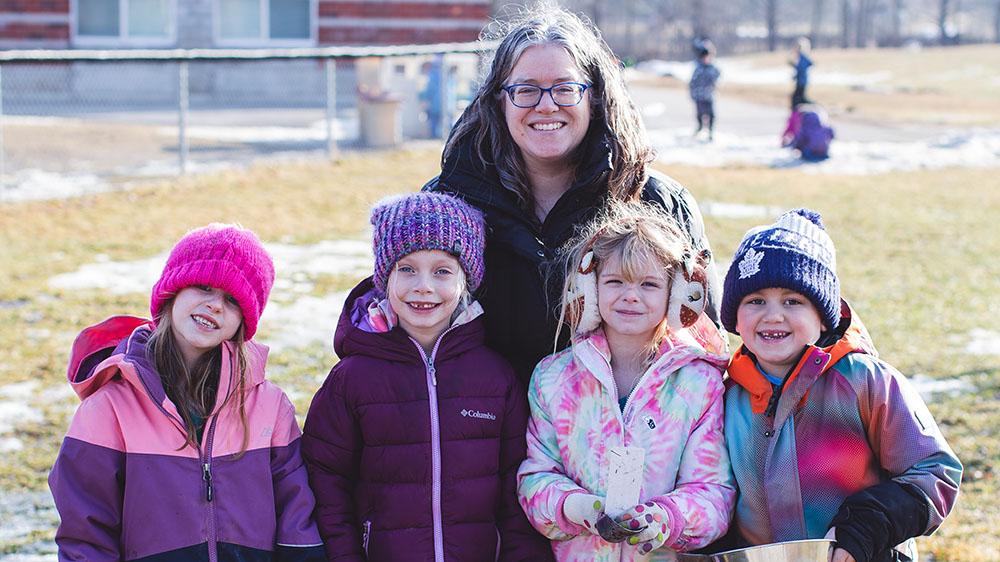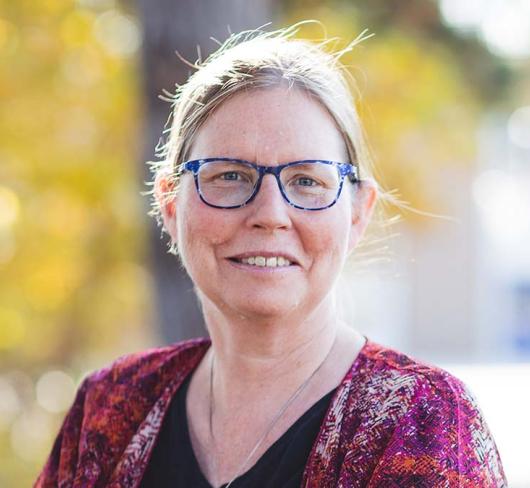
Nurturing a Love of the Land to Promote a Sustainable Future
A winter break from school with little to no snow is slowly becoming the norm. Global warming is a modern-day reality, whether we like it or not, and an issue we need to address with even our youngest learners. As educators, how do we create a world of critically minded students who can fight climate change without causing distress? How can we help students look ahead to creating a sustainable future? One thing that I have done in my own classroom is focus on a world of green spaces. Through these spaces, I work with my students to foster a love of nature and a commitment to stewardship. Spending time in green spaces is a creative way to tie regular classroom lessons into the environment. With climate change, lessons that encourage our students to really connect to the land and the nature spaces around them are increasingly important.
Young Explorers, Young Activists
Young students are eager to learn about their environment. This past year, as part of a Social Studies unit called “Our Local Community,” my group of Grade 1 learners investigated our local green spaces. We began our exploration in the closest available green space: our own schoolyard. The lesson began inside our classroom. Students were prompted to consider the nature in our schoolyard with questions such as, “What kinds of plants do we have out there?” and “When you are outside in the schoolyard, what types of activities do you like to do?” They were able to share that there were grass and trees in our schoolyard, but didn’t Young students are eager to learn about their environment. This past year, as part of a Social Studies unit called “Our Local Community,” my group of Grade 1 learners investigated our local green spaces. We began our exploration in the closest available green space: our own schoolyard. The lesson began inside our classroom. Students were prompted to consider the nature in our schoolyard with questions such as, “What kinds of plants do we have out there?” and “When you are outside in the schoolyard, what types of activities do you like to do?” They were able to share that there were grass and trees in our schoolyard, but didn’t name the different types and had not examined all the other plants around the field’s edges. Next, we went outside to check how accurate their memories were and to see what we could discover.
This experience led into a life sciences unit on living things, where we worked together to notice the unique elements of each schoolyard plant. The students’ excitement grew as the visual learners showed me how many different colours of flowers they found and the leaf types on each of the different trees. The kinesthetic learners began making piles of all the pine cones under the big pines on the property. Together they discovered that there were many more plants and living things in our schoolyard than they had initially remembered.
After our lessons on the school grounds, it was time to take what we had learned about the schoolyard further and go on a few community walks to examine what other local green spaces were like. Were they as big? What did they have to offer our students and their families?
Our schoolyard is next to a large public park. In that park there is one playground structure, a covered picnic area, baseball fields and a relatively new splash pad. There are very few trees or other examples of nature in the park; it consists mostly of grass. We are located relatively close to a major highway. There is one, small playground within the subdivision that is right next to the school building, but it contains a play structure and nothing more.
On our neighborhood walk, students talked about how often they used the splash pad, playground equipment and baseball diamond at the local park. Many students pointed out how close the houses were to one another, the different kinds of trees and flowers that were in front of each house, as well as the lack of plants and trees in the local play area. We used these observations to help guide our thinking for our next steps.
When we returned to the classroom, students began drawing pictures of the green spaces near their houses and thought about what other local green spaces exist in our area. This exercise was extended into map creation lessons, with one of two ideas as prompts for their work: create a whole new green space for the community or improve a current space. Where would a new space go in our community? What would we enjoy in a green space? What type of green space would benefit our community as a whole?
My Grade 1 class had a few ideas that were way outside the box, including some very creative tree house suggestions, a new water park and giant slides. They had a lot of other eco-friendly ideas as well, with many students leaning toward developing community gardens. They thought this was an idea that would benefit the whole community. Our area struggles with food insecurity. We have an ever-increasing need for our local community to use the food bank. There is one community garden already in place that is run by a local church and organized by a retired teacher. She has inspired me to push for a similar model in our area (across town) that is more accessible to affected families. Together we thought how great it would be for students and the community to grow food together in a local community garden, fostering the idea of sustainability and sharing access to fresh vegetables and herbs with students, their families and our neighborhood.
After developing and discussing their ideas for new or improved community green spaces, the students used what they had learned and created to write letters to the Port Hope Town Council with their recommendations for better green spaces and more support for our community.
Dear Port Hope Town Council,
We, the Grade 1 students of BSPS, have been investigating green spaces around our town. We want to say thank you for the splash pad and the baseball fields and the playgrounds that we can use. However, we don’t see much green, other than grass, in our parks. Here are some of our ideas on how we can make our green spaces better:
- More trees
- Tree houses
- Lots more flowers
- A community garden that we can all use to grow food for each other
– Sincerely, the Grade 1 students of BSPS
As I grow this lesson, I find new ways to engage my students. Last year I attended a workshop run by Pathway to Stewardship and Kinship in Peterborough. They introduced the idea of the Wonder Wagon to me. The Wonder Wagon is an exploration kit that you can take on a community or nature walk to allow students to become more engaged with their outdoor surroundings.
In the fall of 2023, I created a Wonder Wagon for my school a bin full of materials that support exploration. The class had fun using it to explore our schoolyard. We began inside by reading the book I Wonder by Annaka Harris. We then took the big bin outside and used it to explore our surroundings. Students really enjoyed using the magnifying glasses, collection cups, biodiversity identification placemats from the University of Guelph Arboretum and many other items in the bin.
It has now been a year since my students wrote letters to their municipal representatives. The class has maintained its communication with one town councillor and we have a project in mind for later in the school year, which will include participation from older grades. We have applied to the town council for funding to pay for the wood and soil we need to build raised garden beds. With the help of our community, our plan is to have the Junior students do the building and the Primary students focus on the growing. The end goal? Building and maintaining raised garden beds that can help feed our local community. Wish us luck!
Starting Small
By starting small, we can instill a desire in students to improve, take ownership of, and develop our green spaces through connection, love and responsibility for their local community and stewardship of the local environment. In Grade 1 Social Studies, teachers work to help students develop an appreciation for the need to treat all humans and the environment with respect. I highly encourage each of you to take a look at your long-range plans and see how you can make your lessons connect with the outdoors, even in a small way, to help foster active citizens and stewards of the earth.
Christina Wilson is a member of the Kawartha Pine Ridge Teacher Local.
Resource List:
- Connecting the Dots, by Stan Kozak and Susan Elliott (Learning for a Sustainable Future) lsf-lst.ca/resources/connecting-the-dots
- Climate Change Primer (Elementary Teachers’ Federation of Ontario) https://members.etfo.ca /resources/classroom-resources/climate-change-primer
- Creating Environmentally and Socially Active Communities, (ETFO) https://members.etfo.ca/resources/classroom-resources/creating-environmentally-and-socially-active-communities
- K-8 Environmental Education: Scope and Sequence 2017, (Ontario Ministry of Education) https://www.edu.gov.on.ca/eng/curriculum/elementary/environmental_ed_kto8_eng.pdf
- United Nations Sustainable Development Goals https://sdgs.un.org/goals
- Pathway to Stewardship and Kinship pathwayproject.ca
Build your own Wonder Wagon.
Pathway to Stewardship and Kinship has great advice on their website for how to create your own kit. Here's what we included in ours:
- curriculum points and ideas for each grade level
- forest games
- sensory bins
- tools for measuring
- string
- colour-matching paint chips
- books to engage students in exploring and questioning
- magnifying glasses
- collecting baskets
- nature posters
- soup/mud kitchen items

